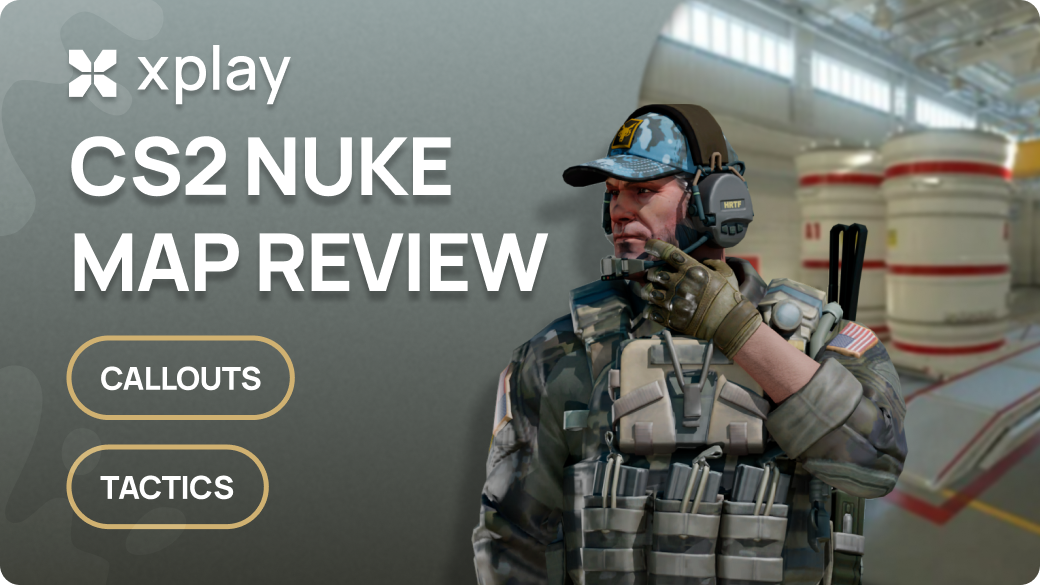CS2 Nuke Map Review: Callouts and Tactics

Nuke is an integral part of the current set of cards for matchmaking and professional tournaments. Known for its intricate design, it attracts players because it offers the most dynamic gameplay. Its unique layout creates a labyrinthine environment that challenges but rewards teams.
This two-tiered battlefield requires strategic navigation and effective coordination to capture and defend territory successfully. Therefore, the xplay.gg team will talk today about which tactics suit Nuke and the most critical callouts.
Highlights
- Overview of the map Nike
- Explanation of essential callouts on Nuke
- Strategy tips for T and CT sides on Nuke
Overview of the Nuke Map in CS2
Nuke is a unique map in CS2, offering a mix of indoor and outdoor combat with two plots, A and B. The verticality of the map, with areas such as Rafters and Vent, makes the game challenging but rewards teams that are good at coordination.
Mastering callouts on this map requires an understanding of its layered design. In addition, this map has narrow Choke Points, which should encourage players to utilize grenades and flashes.
We also reviewed the redesigned Train map in our CS2 Train Map Review: Callouts and Tactics article. You can play matchmaking and custom maps on xplay.gg servers. Read more in the article What are CS2 Community Servers? How to Connect and Why You Should Play on Them.
Nuke's Main Callouts for CS2 Players
CT-Spawn and A Plant
T-Spawn is the starting point for the terrorist team. Next to the T-Spawn is the T Roof, which can be accessed by stairs and also serves as the entry point to Silo.
The Outside, located between Silo, Garage, Secret, and A Main, is essential for moving around key locations. Adjacent to the CT Spawn and the Secret is the Garage, a strategic location often used by CT AWPers to guard the Silo.
CT-Spawn: The defenders' initial lineup constitutes the core of the defensive strategy.
Hell: The area below nine is an entrance for defenders into the Nuclear Block.
Heaven: Elevated area above a base, providing a tactical benefit to those defending.
Lockers: Passageway from the main entrance to the Nine stairs.
Main: Immediate access to A plat from the street.
Vent: A shaft connects A plinth to the lower map tier, facilitating tactical movement.
Tetris: A gentle incline on the upper tier of the A plat provides a strategic height advantage.
Mustang: Distinctive location on the A plat's top tier.
Rafters: A gentle incline on the upper tier of the A plat provides a strategic height advantage.
Hut: A small room initiating aggressive maneuvers to capture a platoon.
T-Spawn and Outside
Just as T-Spawn is critical to the terrorist team, CT-Spawn is crucial to the counter-terrorist team. CT-Spawn is the starting point for members of the counter-terrorist team in each round. Next to it, you will find the CT Box, a strategic obstacle located next to the stairs leading from CT Spawn.
The A Site is in the A-Plant area, where the counter-terrorist team can plant an important bomb. The big box in the A Site provides cover and strategic positioning for both attackers and defenders.
T-Spawn: The location where attackers begin, laying the groundwork for their offensive strategies.
T Roof: A reachable rooftop connected to T-Spawn and the Lobby, providing tactical benefits, like cliff jumping or control during the pistol round.
Silo: A tall pipe next to the roof, named for its resemblance to a steep cliff from CS 1.6.
T Red: A broad term referring to a position associated with a red box on the street.
Outside: The general term for the areas surrounding the central atomic block in Nuke.
Secret: This set of stairs leads down to the lower tier of the atomic block, specifically the B site.
Garage: Refers to the spacious Garage located near the secret entrance.
Blue: A general reference related to the blue box located on the street.
Small Box: A small shelter positioned near the main entrance next to the blue box.
CT Box: A hidden container near the CT Box, often used by snipers on the defense side to control the street.
Lobby and Ramp
Located next to T Spawn, the Lobby, bounded by Sandbags, Squeaky, and Radio, offers players many strategic options.
On the other hand, the Ramp position provides access to the B Site and plays a vital role in defense, making it a key zone that both attackers and defenders need to master.
Turn Pike: The route from the main entrance to the ramp is essential for tactical movement.
Stack: Crates at the ramp's outer corner provide cover and strategic benefits.
Boost: A tactical location near the tunnel exit allows for elevated positioning advantages.
Big Box: A large box before the descent to the B plat ramp offers cover and tactical options.
Ramp: The key descent path to the B plinth, essential for offensive maneuvers.
HS Headshot: An important box at the back of the ramp, vital for gameplay that involves sniping.
Lobby: A spacious area that provides access to A plinth or ramp positions.
Squeaky: A small section close to the Lobby, frequently utilized for strategic placement.
Radio: The starting room that connects the Lobby to the ramp is crucial for movement and communication.
Trophy: The area after the radio corner, recognized for its glass-encased trophies.
Control: The last room before the ramp is critical for strategic movement and control.
B Cross and B Plant
These are the areas where players must first plant a bomb or cross to a point. Point B, the area designated for planting the bomb, is the most critical target for the attacking group, emphasizing the strategic importance of B Cross and B Plant strategies.
Tunnels: Narrow corridors post-descent into Secret, crucial for strategic maneuvering.
Vents: A ventilation shaft linking the ascent to A Plant and the tunnels, facilitating tactical movement.
BackVents: Leftmost passage along the ventilation shaft leading to decon.
Decon: A room post-back vents descent, housing a door opening to B Plant.
Doors: Another entrance to B Plant is accessible from the tunnel side.
Window: A glass-enclosed room above the double doors.
Dark: A concealed spot behind a far B Plant corner crate.
Toxic: A specific area for C4 installation is located in the upper left corner of B Plat, close to the ramp exit.
B Default Plant: The Standard C4 plant site is behind the reactor on the far B Plant side.
Bottom Ramp (Bottom ramp or fork): The two B Plant exits on the ramp side.
Tips for Dominating Nuke in CS2
It would help if you went beyond the basics to become a dominant force in Nuke. One of the key strategies to dominate this challenging map is throwing grenades correctly.
Understanding the optimal smoke points and utilizing them effectively can limit sight lines, obstruct visibility, and make it difficult to fire through the air shaft leading to the vents, giving you a significant strategic advantage.
Smoke aside, you also need to communicate well as a team and coordinate with each other. Communication skills are more important on this map than any other.
Also, pay attention to strategizing for CT and T. Once you understand how these two sides operate, you can make faster decisions and understand what your opponents are doing, which will give you an advantage.
On xplay.gg, there are tools to improve your skills, such as Skillpass. Read more about this feature in the article Skillpass: Earn Rewards Based on Your CS2 Skills with Xplay.gg.
Tips for getting better at nuke?
by u/thesneakerbog in cs2
Smoke Guide for Nuke
Smoke grenades can be used effectively by blocking your view, providing a safer route when traveling in the outer area. This is why they are one of the key tools on this map. The main points you should look out for:
- Trophy – Ramp Smoke
- Turn Pike – Trophy Smoke
- T Roof – Heaven Outside Smoke
- T Roof – A Vent Smoke
- Squeaky – A Main Smoke
- T Spawn to Mini
- T Spawn to Squeaky Door A Main
- Silo to Heaven
- Silo to Outside Heaven (Catwalk)
- Dual Smoke to Outside
Creating a smoke wall on Nuke involves one player throwing smoke into a blue container outside the terrorists' revival point. In contrast, another player simultaneously launches smoke, effectively creating cover and obstructing the view for attackers.
Game Strategies for T in Nuke Map
Execute upper site with meticulous smokes and flashes to block CT vision and disrupt potential AWPer positions. Coordinate pushes through squeaky and main to establish map control. Use molotovs to clear out common hiding spots and secure bomb plant positions. Be prepared for post-plant scenarios and CT rotations.
Establish control outside early in the round. Use smokes and flashes to limit CT vision and power. Consider splitting the map between upper and lower sites, with players controlling the Outside and Ramp. This creates opportunities for flanking and disrupting CT defenses during site executions.
You can read more about the strategies for each map in the CS2 Competitive Map Pool Review and Tactics article.
Game Strategies for CT in Nuke Map
Establish a solid defense on the Upper Bombsite by deploying players in positions like Heaven, Rafters, and Control Room. Use long-range engagements to control outside and squeaky doors. Coordinate with teammates to repel T pushes through squeaky and main. Deploy utility wisely to stall enemy advances and gather early information.
Consider holding positions like the Ramp, Control Room, and Decontamination on the lower bombsite. Use smoke and Molotovs to delay enemy advances through the ramp and lower vents.
Controlling the Outside and Garage is vital for CTs. Experiment with setups that allow for early information gathering in these areas. Use utility to contest T pushes through the yard and Garage. Be ready to adapt to T strategies and rotate quickly between upper and lower sites based on the gathered intel.

